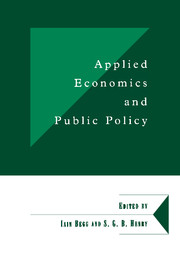Book contents
- Frontmatter
- Contents
- List of figures
- List of tables
- List of contributors
- Foreword
- 1 Introduction
- Part One MODELLING AND FORECASTING METHODS
- Part Two COMBINING DATA AND ANALYTIC TECHNIQUES
- 6 Takeovers, institutional investment and the persistence of profits
- 7 Semi-parametric estimation of the company size–growth relation
- 8 Wage-earnings in Great Britain during the Industrial Revolution
- 9 Company failure and hysteresis
- Part Three USING MODELS TO GUIDE POLICY
- Bibliography
- Index
8 - Wage-earnings in Great Britain during the Industrial Revolution
from Part Two - COMBINING DATA AND ANALYTIC TECHNIQUES
Published online by Cambridge University Press: 06 July 2010
- Frontmatter
- Contents
- List of figures
- List of tables
- List of contributors
- Foreword
- 1 Introduction
- Part One MODELLING AND FORECASTING METHODS
- Part Two COMBINING DATA AND ANALYTIC TECHNIQUES
- 6 Takeovers, institutional investment and the persistence of profits
- 7 Semi-parametric estimation of the company size–growth relation
- 8 Wage-earnings in Great Britain during the Industrial Revolution
- 9 Company failure and hysteresis
- Part Three USING MODELS TO GUIDE POLICY
- Bibliography
- Index
Summary
Introduction
British Economic Growth (1962) by Phyllis Deane and W. A. Cole is widely recognised as one of the most influential of all the books to have emerged from research undertaken in Cambridge at the Department of Applied Economics. It represented the first sustained attempt to estimate historical national income accounts for the United Kingdom, and to make these the basis for the analysis of Britain's economic growth. This work, together with the associated compilation of historical statistics by Brian Mitchell (1962), transformed our knowledge and understanding of the nature and pattern of the developments in Britain in the eighteenth and nineteenth centuries. The application of these quantitative and analytical techniques for the study of the Industrial Revolution and the subsequent phases of economic growth has been enormously influential and stimulating, both here and abroad. Many others have sought to emulate their methodology; some have even borrowed their title; none can claim their originality or their scholarly achievement.
It is thus a great pleasure to be able to contribute to this volume to mark the 50th Anniversary of the DAE, and to pay this tribute to the authors of British Economic Growth. More than thirty years later their research is still the essential starting point for any quantitative study of the economic growth of the British economy. Inevitably, however, their demonstration of the data which could be found and of the procedures which could be applied has made it possible for those who followed after them to improve on certain aspects of their work.
- Type
- Chapter
- Information
- Applied Economics and Public Policy , pp. 181 - 208Publisher: Cambridge University PressPrint publication year: 1998
- 10
- Cited by



